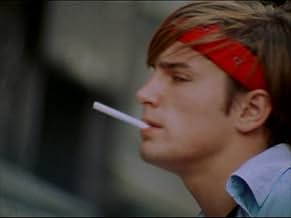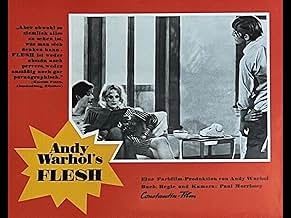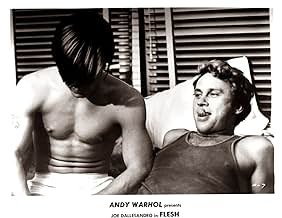CALIFICACIÓN DE IMDb
5.7/10
2.7 k
TU CALIFICACIÓN
Un hombre desesperado por dinero y sin ingresos, se convierte en prostituto e interactúa con una variedad de clientes y estafadores.Un hombre desesperado por dinero y sin ingresos, se convierte en prostituto e interactúa con una variedad de clientes y estafadores.Un hombre desesperado por dinero y sin ingresos, se convierte en prostituto e interactúa con una variedad de clientes y estafadores.
- Dirección
- Guionista
- Elenco
- Premios
- 1 premio ganado en total
Roberto D'Allesandro
- Boy in the Street #2
- (sin créditos)
Jed Johnson
- Solicitor
- (sin créditos)
- Dirección
- Guionista
- Todo el elenco y el equipo
- Producción, taquilla y más en IMDbPro
Opiniones destacadas
It seems inhumane to describe someone as a work of art but in the Warhol
Art Sphere there seems little other way to describe Joe Dallesandro in
"Flesh". His body is displayed constantly in the nude, more consistently
naked than any other actor I can think of in American film history.
Warhol/Morrissey (the authorship of the movie remains contentious though
Morrisey is the credited director, the film rides under the "Andy
Warhol's" banner) objectify and expose every part of Dallesandro's
hustler in the film. He was truly the first sex symbol of the 70s. It
was only in "Flesh" he was so un-self-conscious and innocent though
always with survivalist and self-serving cunning. Joe (the character) is
an interesting kafka-esque (unable to control the world around oneself,
prone to the ebb and flow of circumstance and external control) figure
in the midst of a collage of underground culture figures of the 60s from
drag artistes to quivering tricks. Its a high camp affair at times but
Morrissey has a loving camera when it comes to Joe. Joe's beauty is
vividly captured and the fly-on-the-wall style story of a day in his
life remains engaging a
Art Sphere there seems little other way to describe Joe Dallesandro in
"Flesh". His body is displayed constantly in the nude, more consistently
naked than any other actor I can think of in American film history.
Warhol/Morrissey (the authorship of the movie remains contentious though
Morrisey is the credited director, the film rides under the "Andy
Warhol's" banner) objectify and expose every part of Dallesandro's
hustler in the film. He was truly the first sex symbol of the 70s. It
was only in "Flesh" he was so un-self-conscious and innocent though
always with survivalist and self-serving cunning. Joe (the character) is
an interesting kafka-esque (unable to control the world around oneself,
prone to the ebb and flow of circumstance and external control) figure
in the midst of a collage of underground culture figures of the 60s from
drag artistes to quivering tricks. Its a high camp affair at times but
Morrissey has a loving camera when it comes to Joe. Joe's beauty is
vividly captured and the fly-on-the-wall style story of a day in his
life remains engaging a
Flesh is the first film of a trilogy by Paul Morrissey and Andy Warhol, and is perhaps the first attempt to create an icon of desire out of a male leading role. Although the film is focused on an uncomplicated character development of Joe (Joe Dallesandro), a gentle and subtly unhappy hustler, it depicts him as a passive and ambivalent object, who, in spite of a semi-evident sense of self-control, is possessed, shaped, and evaluated entirely by others. Joe is a young and somewhat naive Adonis who exudes comfort and beauty in his independence, but he works the streets to support his lesbian wife and her girlfriend. He is restlessly bored by an artist/customer's speeches on Greek athletic sculpture and 'body worship', but he sells his nudity anyway. He regards the increasing advances of his homosexual friend with ambivalence, but lets them happen nonetheless. This passivity dominates the film and succeeds in creating a visceral element to Dallesandro's appeal: not only is he desired, he is had.
Perhaps the film's most interesting element is the balance of its obviously experimental nature with its palpable directness. The snappy editing and fragmented dialogue make it fresh and 'real', yet it manages not to rely on the clichéd abstractness of art-films. It is rough, and indeed a weaker effort than Trash or Heat, but nonetheless presents a collection of perfectly plausible characters in a light of almost absolute neutrality.
Perhaps the film's most interesting element is the balance of its obviously experimental nature with its palpable directness. The snappy editing and fragmented dialogue make it fresh and 'real', yet it manages not to rely on the clichéd abstractness of art-films. It is rough, and indeed a weaker effort than Trash or Heat, but nonetheless presents a collection of perfectly plausible characters in a light of almost absolute neutrality.
Although the film opens with the credit "Andy Warhol Presents", it was actually written, photographed and directed by cult film-maker Paul Morrissey (according to Morrissey, all Warhol provided was money and publicity).
Joe Dallesandro (immortalised as "little Joe" in the Velvet Underground song "Walk on the Wild Side") plays Joe, a slightly dim-witted male prostitute, who is supporting his bisexual wife and baby. His wife wants him to come up with $200 for her girlfriend's abortion. We basically follow Joe around as he encounters various characters willing to help him, including an artist who wants to pay him to pose nude, and Warhol "superstars" Candy darling and Jackie Curtis.
Despite being amateurishly shot, with countless technical errors, the most annoying of which is a very badly-recorded soundtrack, the film is fascinating due to it's delving into a world rarely seen on mainstream screens, which probably doesn't exist anymore. Although many scenes do go on for too long, it's too startling to be dull. Fans of Joe Dallesandro will no doubt enjoy his frequent exposure (he provides most of the flesh of the title).
If you're a fan of cult or underground films, you'll not want to miss this. It was followed by "Trash" (1970) and "Heat" (1972) to form a loose trilogy.
Joe Dallesandro (immortalised as "little Joe" in the Velvet Underground song "Walk on the Wild Side") plays Joe, a slightly dim-witted male prostitute, who is supporting his bisexual wife and baby. His wife wants him to come up with $200 for her girlfriend's abortion. We basically follow Joe around as he encounters various characters willing to help him, including an artist who wants to pay him to pose nude, and Warhol "superstars" Candy darling and Jackie Curtis.
Despite being amateurishly shot, with countless technical errors, the most annoying of which is a very badly-recorded soundtrack, the film is fascinating due to it's delving into a world rarely seen on mainstream screens, which probably doesn't exist anymore. Although many scenes do go on for too long, it's too startling to be dull. Fans of Joe Dallesandro will no doubt enjoy his frequent exposure (he provides most of the flesh of the title).
If you're a fan of cult or underground films, you'll not want to miss this. It was followed by "Trash" (1970) and "Heat" (1972) to form a loose trilogy.
Because this flick is the first feature fruit of a long lasting collaboration between Paul Morrissey, Andy Warhol and Joe Dallessandro, it is too much obvious that it was mostly made for having fun among themselves. The script is quite loose, the dialogues are too obviously improvised, one even suspects that there probably is no script at all, just thematic concepts: prostitution, addiction and poverty (which all seem to continue in the following films Trash and Heat).
Joe Dallessandro reveals unashamedly his gorgeous body at any chance, to the hungry eyes of other addicts (not only drug addicts).
Although the whole film seems like amateurish, especially the scene with other hustlers at the park is very intriguing, like a documentary project.
I would not recommend to see this by itself, but watching the trilogy (Flesh, Heat and Trash) altogether will be much enlightening.
Joe Dallessandro reveals unashamedly his gorgeous body at any chance, to the hungry eyes of other addicts (not only drug addicts).
Although the whole film seems like amateurish, especially the scene with other hustlers at the park is very intriguing, like a documentary project.
I would not recommend to see this by itself, but watching the trilogy (Flesh, Heat and Trash) altogether will be much enlightening.
In a lot of ways this film defines the essence of everything I love about cinema, in terms of capturing those strange, elusive moments of unguarded truth. In other ways, it is undeniably an amateurish, unfocused result of junkies self-indulgently fooling around with a camera. Ultimately it comes out somewhere between pure brilliance and unwatchability (thankfully much more so the former than the latter). Part of me wants to reward it solely for it's absolute innovativeness and moments of pure sublimity, but at the same time I can't completely ignore the occasionally downright awful "acting" and overtly bad production values. At first the editing seems overwhelmingly sloppy and needlessly distracting (or maybe just wrongheadedly "innovative"), but after a while I got used to it, which is, in the end, the true sign of whether a film succeeds on it's own terms or not. I guess that answer basically sums up my all-around feelings for the film. That is, despite it's in-ignorable flaws, on a whole it does work very well. And, if nothing else, a film like this really shows how false and contrived the faux-documentary, shaky-cam style can sometimes be when it so obviously applied purely for effect (such as in films like the otherwise admirable Roger Dodger). Here the aesthetics are plainly derived from the necessities of the filming situation, and are not just used arbitrarily to make it look "cool".
¿Sabías que…?
- TriviaUK censor John Trevelyan was wary of issuing the film a cinema certificate and suggested to the distributors that the film be shown on a club basis. When it was initially shown at the Open Space Theatre in London in February 1970 the cinema was raided by police who attempted to seize the film, leading Trevelyan himself to hastily rush to the cinema and vigorously defend the movie against possible prosecution, calling the police action 'unjustified and preposterous'. In the light of this incident Trevelyan was able to grant the film an uncut 'X' certificate.
- ErroresDuring a scene with the go-go dancer, Candy and Jackie alternately call her by the character's first name (Terry) and that of the actress playing her (Geri Miller).
- Citas
Joe, the Hustler: How am I supposed to make any money without clean underwear?
- Créditos curiososThe opening credits run sideways and list Warhol's name, the title, the main cast members, and that it was written, photographed and directed by Paul Morissey.
- ConexionesEdited into Porno & libertà (2016)
- Bandas sonorasMakin' Wicky Wacky Down in Waikiki
Performed by Sophie Tucker.
Selecciones populares
Inicia sesión para calificar y agrega a la lista de videos para obtener recomendaciones personalizadas
- How long is Flesh?Con tecnología de Alexa
Detalles
- Fecha de lanzamiento
- País de origen
- Idioma
- También se conoce como
- Andy Warhol's Flesh
- Locaciones de filmación
- Greenwich Village, Nueva York, Nueva York, Estados Unidos(At the apartment of critic David Bourdon)
- Productora
- Ver más créditos de la compañía en IMDbPro
Taquilla
- Presupuesto
- USD 4,000 (estimado)
- Tiempo de ejecución
- 1h 29min(89 min)
- Mezcla de sonido
- Relación de aspecto
- 1.37 : 1
Contribuir a esta página
Sugiere una edición o agrega el contenido que falta


























